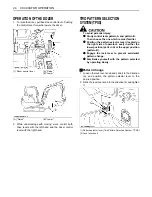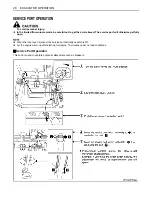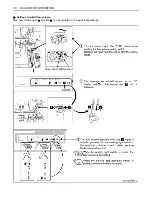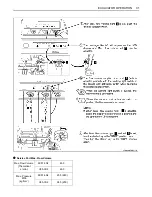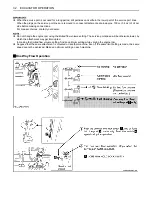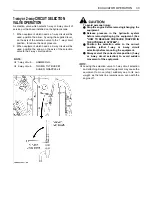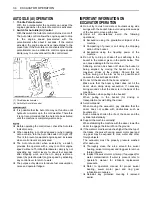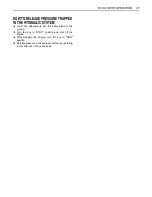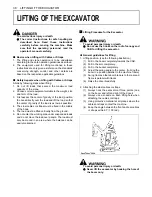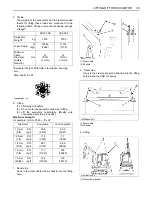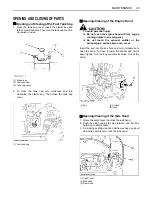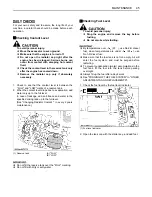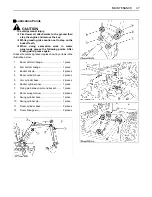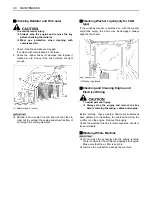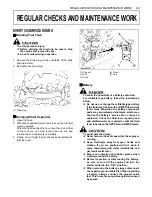
EXCAVATOR OPERATION
34
AUTO IDLE (AI) OPERATION
1.
Throttle Potentiometer
With this potentiometer the operator can adjust the
engine speed when the Auto Idle control is activated.
2.
Switch for Auto Idle (AI) Control
With this switch the Auto Idle control is turned on or off.
The Auto Idle control allows the engine speed to drop
to the engine speed preselected with the
potentiometer after about 4 seconds. If the control
activated, the engine speed rises immediately to the
preset rpm. If the Auto Idle is not activated the throttle
potentiometer can be utilized to control engine speed
similar way to a conventional throttle control lever.
A
It is possible that the Auto Idle may not function until
hydraulic oil warms up in the cold weather. Therefore
it is not recommended that the Auto Idle be activated
until the machine is completely warmed up.
A
Before operating the control lever, check the Auto Idle
Indicator Lamp.
A
When operating in confined spaces or when loading
onto a vehicle, turn the Auto Idle switch off (Light off).
This is to prevent unwanted engine speed increases
when control levers are activated.
A
The Auto Idle control, when selected by a switch,
provides the operator with a way to control engine
speed without a Throttle Potentiometer, simply by not
activating any control levers for about four seconds
after stopping work, and then to simply restore a
preset (by potentiometer) engine speed by activating
any control lever to return to work.
A
The purpose of system is to reduce fuel consumption,
noise and operator fatigue.
IMPORTANT INFORMATION ON
EXCAVATOR OPERATION
A
Do not try to crush concrete or boulders using side
swings with the bucket. Also avoid using side sweeps
of the bucket to move earth piles.
A
Under all circumstances avoid the following
operations:
A
Excavation using the gravitational impact of the
machine.
A
Compacting of gravel or soil using the dropping
action of the bucket.
A
Excavation using the traveling power of the
machine.
A
Do not try to drop or shake off soil adhering to the
bucket in the manner given in the points below. This
can cause damage to the machine.
Adhering soil can be shaken off when the bucket is
being emptied by moving the bucket out to the
maximum stroke of the cylinder. Should this not
suffice, swing out the arm as far as possible and
operate the bucket back and forth.
A
Do not hit the dozer with the boom cylinder!
Make sure that the boom cylinder does not hit the
dozer when doing deep excavation. If necessary
swing around so that the dozer is in the back of the
machine.
A
Pay attention when pulling in the bucket!
When pulling in the bucket (for driving or
transportation) avoid hitting the dozer.
A
Avoid collisions!
When moving the excavator, pay attention that the
dozer does not collide with obstructions such as
boulders etc..
Such collisions shorten the life of the dozer and the
cylinder substantially.
A
Support the machine correctly!
When stabilizing the machine with the dozer, lower the
dozer to engage the full width on the ground.
A
If the water or mud level reaches higher than the top of
the tracks, the swivel bearing, swivel motor gear and
ring gear may be exposed to mud, water and other
foreign objects.
The excavator must be properly pressure washed
after each use.
A
Thoroughly clean the area around the swivel
bearing, swivel motor gear and ring gear to remove
foreign objects.
A
Inspect the swivel motor oil sump (if equipped) for
water contamination. If water is present, refer to
operator's manual for lubricant replacement
procedure.
A
Refer to operator's manual for proper swivel
bearing, swivel motor gear and ring gear
lubrication procedures.
A
Reinstall any protective covering if removed
earlier.
(1) Throttle potentiometer
(2) Switch for Auto Idle control
Summary of Contents for Super Series 2 KX 91-3
Page 14: ...SAFE OPERATION 6 6 DANGER WARNING AND CAUTION LABELS...
Page 15: ...7 SAFE OPERATION...
Page 16: ...SAFE OPERATION 8...
Page 17: ...9 SAFE OPERATION...
Page 18: ...SAFE OPERATION 10...
Page 19: ...11 SAFE OPERATION...
Page 20: ...SAFE OPERATION 12...
Page 95: ...75 LIFTING CAPACITY...
Page 96: ...76 LIFTING CAPACITY...
Page 97: ...77 LIFTING CAPACITY...
Page 98: ...78 LIFTING CAPACITY...





